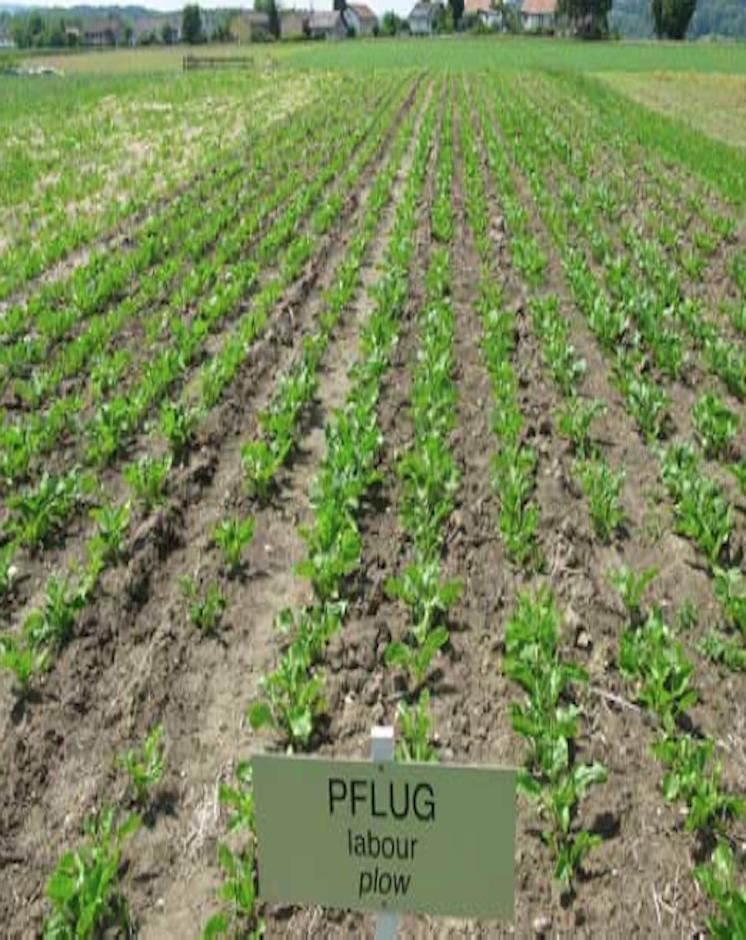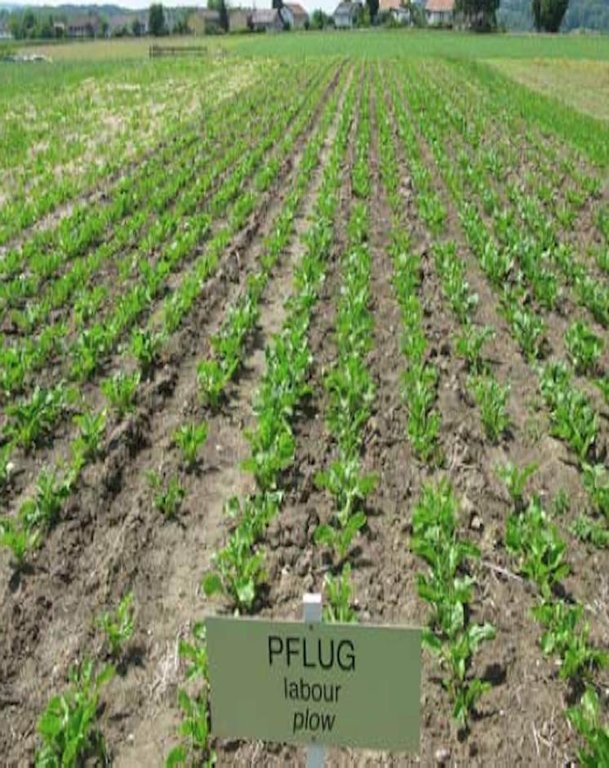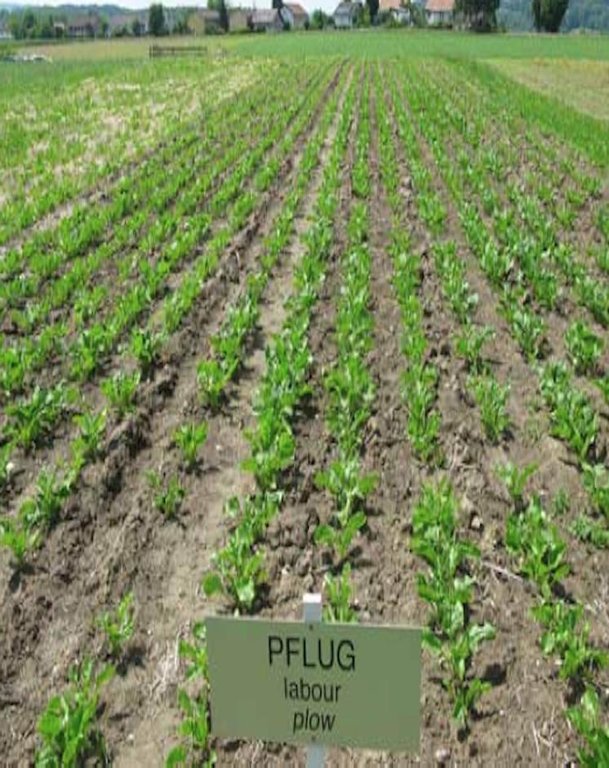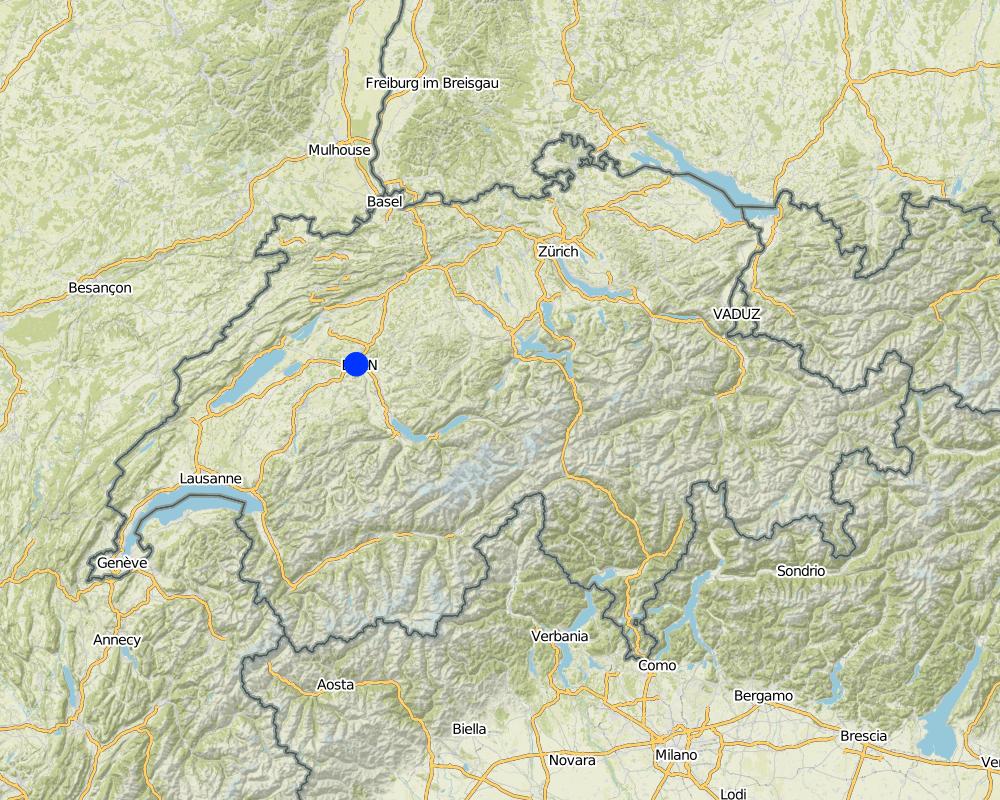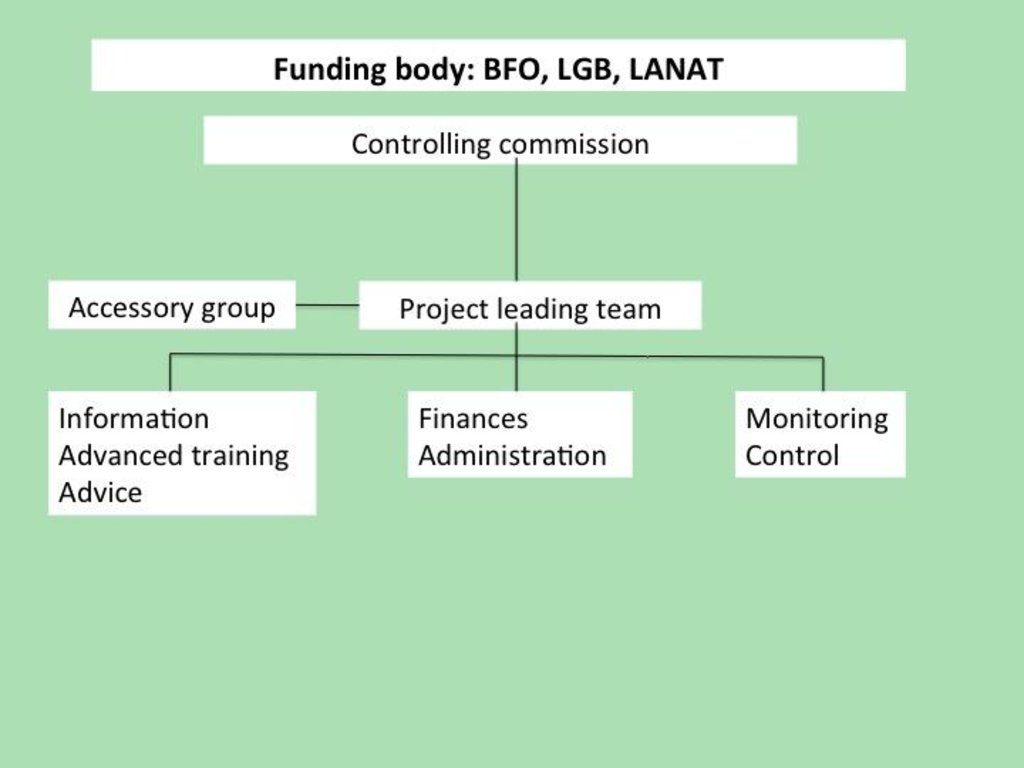Soil support program for conservation agriculture [瑞士]
- 创建:
- 更新:
- 编制者: Deborah Niggli
- 编辑者: –
- 审查者: David Streiff
Förderprogramm Boden des Kantons Bern
approaches_2525 - 瑞士
查看章节
全部展开 全部收起1. 一般信息
1.2 参与方法评估和文件编制的资源人员和机构的联系方式
SLM专业人员:
Sturny Wolfgang
wolfgang.sturny@vol.be.ch
Fachstelle Bodenschutz des Kantons Bern
Rütti, 3052 Zollikofen
瑞士
有助于对方法进行记录/评估的项目名称(如相关)
Preventing and Remediating degradation of soils in Europe through Land Care (EU-RECARE )有助于对方法进行记录/评估的机构名称(如相关)
CDE Centre for Development and Environment (CDE Centre for Development and Environment) - 瑞士1.3 关于使用通过WOCAT记录的数据的条件
(现场)数据是什么时候汇编的?:
06/05/2015
编制者和关键资源人员接受有关使用通过WOCAT记录数据的条件。:
是
1.4 SLM技术问卷的参考
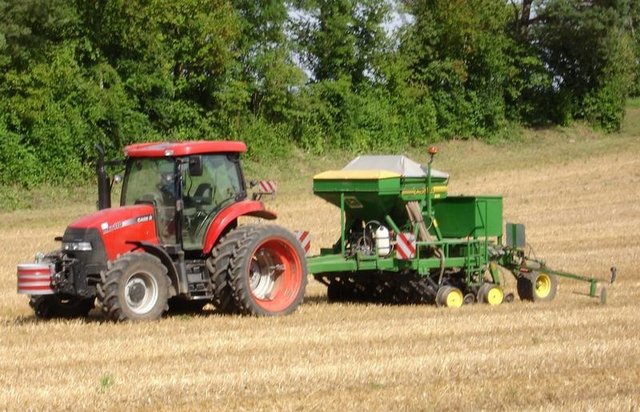
Direct seeding [瑞士]
A cropping system which allows to plant the seeds directly into the soil without ploughing. The soil is covered with plant remainders.
- 编制者: Unknown User
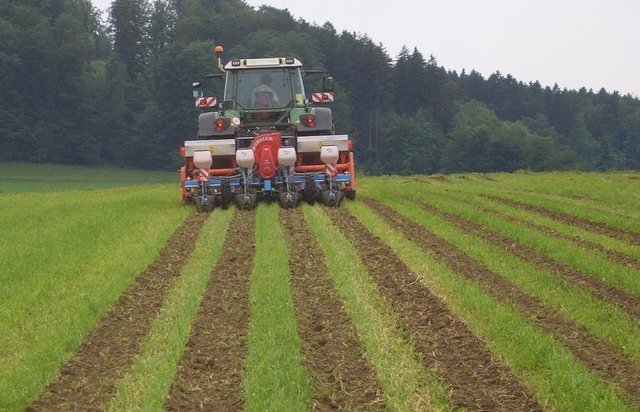
Maize strip tillage [瑞士]
A cropping system for maize which reduces the reworking of the soil to the stripes, in which the seeds are planted.
- 编制者: Joana Eichenberger
2. SLM方法的描述
2.1 该方法的简要说明
Through the soil support program land users get subsidies for applying conservation technologies on their fields during a period of 6 years.
2.2 该方法的详细说明
该方法的详细说明:
Aims / objectives: The aim of the office of soil protection is to enhance the implementation of conservation agriculture technologies by swiss land users. Therefore land users can test different technologies for 6 years within the soil support program. For each technology and method they apply they get paid by the government. Thus the functional character of soil and the soil biology are preserved, soil erosion and soil compaction are prevented and production of ammoniac is reduced.
Methods: The aims named above can be reached by implementing conservation agriculture technologies such as direct seeding or mulching. Therefore, land users get a financial incentive for using and implementing such technologies on their own fields. They apply for a period of 6 years to use conservation technologies. At the beginning, at least two different technologies must be chosen. There are different technologies in the field of soil protecting cropping systems, soil composition and ammoniac reducing spreading systems. Moreover, the office of soil protection has its own testing fields where land users get an overview over the different technologies and can then decide on which method they want to apply. After a land user gets a contract, planning and details about the technology and the process of implementation are discussed separately with an advisor of the program.
A database with all information necessary for land users and controlling institutions is also granted by the office. Controllers of the local government must check the field and the implementation of the technologies of a participant land user at least once a year.
Stages of implementation: The soil support program of the Canton Bern is an extension of a previous program. Results of this previous program showed that regarding soil pollution, soil erosion and loss of nitrogen agricultural production can even be improved when using conservation technologies. Through a new agricultural policy in 2007 government is able to provide financial support for projects enhancing protection of natural resources. The soil support program was then approved 2008 and started its 6-year program in 2009. To promote this project different descriptions were made in press and media, a homepage was launched and through soil days and public speeches information was spread under land users.
When implementing a conservation technology land users get advice and consultations directly through advisors in order to provide as much information and help as possible.
Role of stakeholders: Land users are the most important group of stakeholders. They need to apply to the program and change their cropping system and implement conservation technologies. At the beginning there are many critics among them who don't trust conservation technologies to be as effective and productive as their traditionalist ones. Land users open to a change and concerning the benefit for natural and biological environment apply to the program. It is very important to involve land users and their views and concerns into the process of planning after the contract but also even at the very beginning of the program. If technologies are not compatible with their views they are not going to fully implement a technology and keep it after the program.
Advisors are employed by the program administration. It is their job to provide help to the land users. They are most important in the beginning when a land user chooses his conservation technology. They are on field together with the land user and discuss the best possible technology for the land user. To find the appropriate technology is always a tricky task.
Government and local government play the crucial role of money lenders and supervisors. Representatives of the local government need to check a land user and the application of his conservation technology at least once a year. If it is approved government provides the payment in form of subsidies for the conservation technology applied by the land user. This amount differs from technology to technology.
2.3 该方法的照片
2.5 采用该方法的国家/地区/地点
国家:
瑞士
区域/州/省:
Canton Bern
注释:
Canton of Bern
Map
×2.6 该方法的开始和终止日期
注明开始年份:
1993
终止年份(若不再采用该方法):
2015
2.7 方法的类型
- 基于项目/方案
2.8 该方法的主要目的/目标
The Approach focused mainly on SLM with other activities (water and air pollution, biodiversity, rethinking agricultural practises)
The main aim of the program was to implement conservation technologies into the livelihood of swiss land users. Because of financial incentives land user even get subsidies for implementing a conservation technology on their fields. The other objective not only of the project was to get land users to overthink their traditional view of agriculture and to focus more on the conservation of natural environment and especially soil. Through the project land users shall be encouraged to carry on with the conservation technology they applied in the project. Thus, the main aims focus especially on the implementation and continuation of sustainable land use technologies in swiss agriculture.
The SLM Approach addressed the following problems: Das Hauptproblem zu Beginn des Projekts war die Unwissenheit der Bauern. So kam es teilweise zu Ernteverlusten durch falsche Anwendung einer Massnahme. Zudem ignorierten einige Bauern die Vorschriften des Programms, vor allem bei der Fruchtfolge. Eine Befolgung dieser Vorgaben ist jedoch unerlässlich für die erfolgreiche Einführung einer Massnahme und deren Gelingen. Ein nächstes Problem war der Einsatz von Glyphosat bei der Anwendung von Direktsaat. Dieses Herbizid wird auch in der breiten Bevölkerung nur gering toleriert. Ein letztes Problem waren schliesslich die traditionellen Ansichten einiger Bauern, welche wie ihre Väter und Grossväter nach Ablauf der 6 Jahre zurück auf ihre traditionellen Anbauverfahren wechselten. Hier konnte das Projekt nicht den gewünschten Erfolg erzielen.
2.9 推动或妨碍实施本办法所适用的技术的条件
社会/文化/宗教规范和价值观
- 阻碍
Traditionelle Ansichten der Bauern waren zu Beginn ein Hindernis. In der Schweizer Mentalität soll alles sauber und ordentlich sein, so auch auf dem Feld.
Treatment through the SLM Approach: Unterstützung durch Berater und Hilfe. Man kann Bauern nicht zur Weiterführung einer Technologie zwingen aber sie von den Hauptvorteilen überzeugen. Sie müssen selbst die Vorteile sehen.
财务资源和服务的可用性/可得性
- 阻碍
Zu Beginn sind grössere Ausgaben notwendig, bspw. für die Maschine/Lohnunternehmer und generelle Umstellung.
Treatment through the SLM Approach: Man zeigt den Bauern auf, dass nur zu Beginn mehr Kapital benötigt wird. Nach dem Wechsel zu einer konservierenden Technologie ist die Umstellung sehr profitabel und weniger Kapital als bei konventioneller Bodenbearbeitung ist notwendig.
机构设置
- 阻碍
Institutionen und Vereine wie etwa die Pflanzenschutzfachstelle waren zu Beginn gegen das Programm, weil es den Einsatz von Glyphosat und anderen Herbiziden fördert. Auch der Bildungssektor (Bauernschule) war skeptisch gegenüber der neuen Technologien und deren Erfolg.
Treatment through the SLM Approach: Es war wichtig, die Institutionen davon zu überzeugen, dass die Einführung einer Technologie nicht den Einsatz von Glyphosat vergrössern wollte, sondern das Ziel hatte, bodenschonende Anbauverfahren einzuführen. Diese sind jedoch an den Gebrauch von Glyphosat gebunden. Bauern sind hierbei jedoch selbst für die richtige Menge und den nachhaltigen Einsatz von Glyphosat verantwortlich. Zudem wurden mit Feldbegehungen und Diskussionseinladungen Zweifel und Ängste beseitigt.
了解SLM,获得技术支持
- 阻碍
Es müssen unter Umständen neue Geräte angeschafft werden, die sehr kostspielig sind. Meist ist es jedoch lohnenswerter einen Lohnunternehmer für die Direktsaat zu beauftragen.
Treatment through the SLM Approach: Für die Anschaffung von Geräten und allgemeinen finanziellen Investitionen wird das Gespräch mit der Familie des Bauern (v.a. der Ehefrau) gesucht. Berater zeigen auf, welche technischen Geräte notwendig sind, wann es sich lohnt einen Lohnunternehmer zu beauftragen und welche Geräte nicht mehr notwendig sind (und allenfalls verkauft werden können).
3. 相关利益相关者的参与和角色
3.1 该方法涉及的利益相关者及其职责
- 当地土地使用者/当地社区
Swiss agriculture is dominated by men. Also the advisors and program leaders were mainly men. The decision of implementing a conservation technology however is made by both the land user and his wife who is an important stakeholder as well. Overall, the participation was dominated by men.
- SLM专家/农业顾问
- NGO
LOBAG, LONZA, BFO, Swiss No-Till
- 私营部门
Seed and fertilizer companies
- 地方政府
Canton of Bern
- 国家政府(规划者、决策者)
Federation
3.2 当地土地使用者/当地社区参与该方法的不同阶段
| 当地土地使用者/当地社区的参与 | 指定参与人员并描述活动 | |
|---|---|---|
| 启动/动机 | 被动 | Land users need at first to be convinced to implement the technologies an take part in the program. |
| 计划 | 无 | |
| 实施 | 外部支持 | Land users need to implement the conservation technologies. They get help and support from advisors of the program and get paid for implementing a conservation technology by the federal government. |
| 监测/评估 | 被动 | Land users are part of the monitoring because they reflect themselves and the technology they apply at every stage as well. However, it is the controllers of the local government who evaluate the technology and the application on the field. |
| Research | 互动 | For more information on the implementation and experience of the land users who applied conservation technologies, their part in the phase of research is definitely active. Interaction between research and land users takes place during workshops or field trips. Land users get also more and more interested in research results. |
3.3 流程图(如可用)
具体说明:
Organisation chart of the soil support program of the Canton of Berne
作者:
VOL Volkswirtschaftsdirektion Kanton Bern
3.4 有关SLM技术选择的决策
具体说明谁有权决定选择要实施的技术:
- 主要是SLM专家,咨询土地使用者之后
解释:
Decisions on the method of implementing the SLM Technology were made by mainly by land users supported by SLM specialists
4. 技术支持、能力建设和知识管理
4.1 能力建设/培训
是否为土地使用者/其他利益相关者提供培训?:
是
明确受训人员:
- 土地使用者
- 现场工作人员/顾问
培训形式:
- 在职
- 农民对农民
- 示范区域
- 公开会议
- 课程
涵盖的主题:
Mainly the training of implementing soil conservation technologies got very interesting for the land users. They participate more frequently on trainings than they have to. They learn how to protect their field from erosion by water, when to best cultivate their fields and much more in order to successfully apply a conservation technology.
4.2 咨询服务
土地使用者有权使用咨询服务吗?:
是
指明是否提供了咨询服务:
- 在土地使用者的土地上
说明/注释:
Name of method used for advisory service: Annual meetings; Key elements: technical support, planning of crop rotation and conservation technology, monitoring
Advisory service is very adequate to ensure the continuation of land conservation activities
4.3 机构强化(组织发展)
是否通过这种方法建立或加强了机构?:
- 是,适度
具体说明机构的强化或建立程度:
- 本地
具体说明支持类型:
- 设备
提供进一步细节:
Mainly contractor companies were highly supported because of the conservation technologies which required special technical equipment which was provided by them.
4.4 监测和评估
监测和评估是该方法的一部分吗?:
是
注释:
bio-physical aspects were regular monitored by project staff through observations; indicators: None
technical aspects were regular monitored by project staff through observations; indicators: None
economic / production aspects were ad hoc monitored by land users through observations; indicators: None
area treated aspects were regular monitored by project staff, government through measurements; indicators: None
no. of land users involved aspects were regular monitored by project staff, government through measurements; indicators: None
management of Approach aspects were regular monitored by project staff, government through observations; indicators: None
There were few changes in the Approach as a result of monitoring and evaluation: The aim of reducing the amount of glyphosate came up frequently during the application of conservation technologies.
There were few changes in the Technology as a result of monitoring and evaluation: None
4.5 研究
研究是该方法的一部分吗?
是
明确话题:
- 生态学
- 技术
提供进一步的细节,并指出是谁做的研究:
Different professors of international universities provided important basic informations: John Baker (NZL), Karlheinz Köller (Hohenheim). Also the University of Bern and the technical college provided information on conservation technologies and their implementation
Research was carried out both on station and on-farm
5. 融资和外部物质支持
5.1 该方法中SLM组成部分的年度预算
如果不知道准确的年度预算,请给出一个范围:
- > 1,000,000
注释(例如主要的资助来源/主要捐助者):
Approach costs were met by the following donors: government (Swiss federal government): 80.0%; local government (district, county, municipality, village etc) (Canton of Berne): 20.0%
5.2 为土地使用者提供财政/物质支援
土地使用者是否获得实施该技术的财政/物质支持?:
是
如果是,请具体说明支持的类型、条件和提供者:
Contributions were provided by the federal government. This was part of the Approach.
5.3 对特定投入的补贴(包括劳动力)
如果土地使用者的劳动力是一项重要的投入,那么是不是:
- 以现金支付
注释:
Labour by land users also sometimes voluntarily
5.4 信用
是否根据SLM活动的方法给予信用值?:
否
6. 影响分析和结论性陈述
6.1 方法的影响
该方法是否帮助土地使用者实施和维护SLM技术?:
- 否
- 是,很少
- 是,中等
- 是,支持力度很大
Land user are more conscious about the protection of soil and its functions. No-tillage as a form of sustainable land management was successfully implemented and has good chances of perpetuation. Land users keep the diversity of soils and its structure, prevent soil compaction and have less work to do by applying conservation agriculture. There is also less money and financial capital required.
该方法是否有助于社会和经济弱势群体?:
- 否
- 是,很少
- 是,中等
- 是,支持力度很大
No socially and economically disadvantaged groups were involved.
Did other land users / projects adopt the Approach?
- 否
- 是,很少
- 是,中等
- 是,支持力度很大
Mostly land users open to new technologies and with regard to protection soil and soil erosion adopted the Approach. Neighborhood is also an important factor: if a land user near an other succeeds in applying a conservation technology and getting the benefits of it, it is likely that the other land user adopts the technology for himself.
Did the Approach lead to improved livelihoods / human well-being?
- 否
- 是,很少
- 是,中等
- 是,支持力度很大
Soil and fields of the land user are more protected against erosion and therefore against financial loss of capital, crop failure etc.
Did the Approach help to alleviate poverty?
- 否
- 是,很少
- 是,中等
- 是,支持力度很大
6.2 土地使用者实施SLM的主要动机
- 增加利润(能力),提高成本效益比
- 支付/补贴
- 环境意识
6.3 方法活动的可持续性
土地使用者能否维持通过该方法实施的措施(无外部支持的情况下)?:
- 是
若是,请说明如何维持:
The land users know very much about the conservation technologies and the application of these after the program. They also know which technology is best for their fields. Therefore, they can continue the Approach activities without support. However, the most important reason for the land users to continue is their will to do it. If a land user does not see the difference and is not fully willing to continue he will not do so even if there are subsidies for conservation agriculture.
6.4 该方法的长处/优点
| 土地使用者眼中的长处/优势/机会 |
|---|
| With the program land users get to know how important it is to protect their soils against different types of degradation. The Approach helps to implement technologies to keep soil fertility alive on a longterm view which is highly important. (How to sustain/ enhance this strength: The knowledge of possibilities to protect agricultural fields must be spread even further under land users. Conservation technologies can be applied by every land user no matter how their fields are composed of.) |
| The program and its conservation technologies can provide some protection against future problems to be concerned with climate change. Because soil can keep more water and its storage capacity is enhanced through conservation agriculture, soil can take and hold the water for a longer time. If there is a dry period soils under conservation technologies are less likely to dry out than conventional fields. (How to sustain/ enhance this strength: The storage capacity of soils is an important character of soils and must therefore be protected which means root penetration must be sustained.) |
| When applying conservation technologies, soil is more tolerant to previous dangerous factors like heavy machines. Therefore, great and heavy machines used for conservation agriculture do not provide a risk for compaction to soils. (How to sustain/ enhance this strength: With the application of conservation technologies there are also new possibilities associated like using heavy agricultural machines without compaction. These advantages must also be noticed when debating the benefit of conservation agriculture.) |
| 编制者或其他关键资源人员认为的长处/优势/机会 |
|---|
| With the soil support program land users learn how to best treat and cultivate their fields. The Approach has the advantage that conservation technologies can be applied for each land user individually which means that not every conservation technology is suitable for each land user. The individual solutions for a land user which are possible are a great strength. (How to sustain/ enhance this strength: The diversity of conservation technologies must be sustained in order to provide a great range of different possibilities for the land user. Not every field provides the best conditions for a certain technology.) |
| Land users and their advisors know each other most of the time quite good because advisors themselves come from the agricultural sector. This provides an atmosphere of familiarity which is positive for both of the stakeholders. Problems and ideas can be openly discussed. (How to sustain/ enhance this strength: Advisors must have an agricultural background in order to understand land users and their problems and struggles. With the same knowledge base solutions can be better found and a good working atmosphere is provided.) |
| The support provided by the advisors and the project staff is excellent. Land users get a lot of technical, bio-physical and environmental knowledge from them which they can transfer to their practices. The continuation after the 6 year's duration of the program is therefore mostly granted by the immense support for the land users. They get encouraged to continue conservation technologies and do it because they feel good and strengthened after 6 years of training and practice. (How to sustain/ enhance this strength: Support at the different stages and on different places must be guaranteed. It gives land users and the program itself much confidence of fulfilling the aims. ) |
6.5 该方法的弱点/缺点以及克服它们的方法
| 土地使用者认为的弱点/缺点/风险 | 如何克服它们? |
|---|---|
| There are higher costs at the beginning for conservational agriculture than for conventional agriculture. New machines or contractors are needed to cultivate the fields. | Higher costs at the beginning can not directly be overcome. But it must be mentioned that there will be lower costs after the beginning and that the implementation of a conservation technology on a longterm base is profitable. |
| There is much working effort needed in the beginning for implementing and applying a new technology. The benefit may not always be seen. | Land users themselves must see the advantages even when they need to do more at the beginning. The relationship with other land users and the support of the family plays also a crucial role here. The Approach itself just provides an overview of the advantages and gives advice to the land user. |
| Compared to the number of total land users in the Canton of Bern or Switzerland itself, conservation agriculture is practiced only by about 3%. This number is far too low. | The program can not be unlimited to all land users because of the financial subsidies. It could however be stretched to other Cantons to provide a similar program. But this might be very difficult because of the financial resources. Conventional agriculture must therefore get more attention in public and in politics. |
| 编制者或其他关键资源人员认为的弱点/缺点/风险 | 如何克服它们? |
|---|---|
| The number of applicants is limited by the project. Compared to the total number of land users in Canton Bern there are just few participants to the program. | The conditions for participation could be reduced for land users. This would probably lead to more participants. However, more participants require more subsidies and therefore the costs increase. If government would approve of this is therefore doubtful. |
7. 参考和链接
7.1 方法/信息来源
- 实地考察、实地调查
- 与SLM专业人员/专家的访谈
7.2 参考可用出版物
标题、作者、年份、ISBN:
VOL (Volkswirtschaftsdirektion des Kantons Bern) 2009: Bodenbericht 2009
可以从哪里获得?成本如何?
Bodenfachschutzstelle des Kantons Bern, Rütti, 3052 Zollikofen
链接和模块
全部展开 全部收起链接

Direct seeding [瑞士]
A cropping system which allows to plant the seeds directly into the soil without ploughing. The soil is covered with plant remainders.
- 编制者: Unknown User

Maize strip tillage [瑞士]
A cropping system for maize which reduces the reworking of the soil to the stripes, in which the seeds are planted.
- 编制者: Joana Eichenberger
模块
无模块


